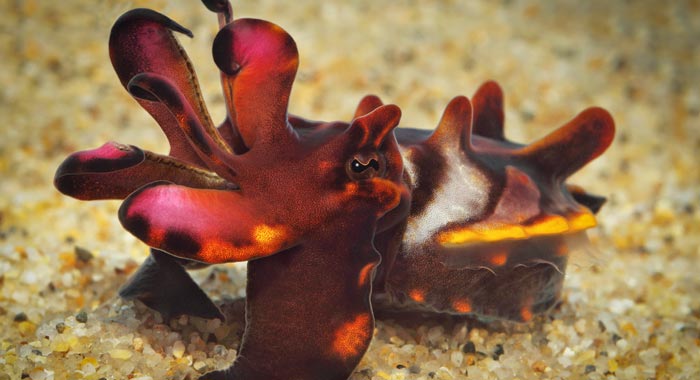Not Your Everyday Story of Cuttlefish
On the fast track to superstardom in saltwater aquaria through his work with the fragile cuttlefish, Bret Grasse ’08 has found his methods so successful that he has become the world’s go-to expert in culturing generations of cuttlefish.
“I was an especially huge shark and fish nerd growing up,” explains Grasse, a rising star at the world-renowned Monterey Bay Aquarium at the ripe age of 26. “I tell young people to follow their dream and do what you want to do. I like fish, and I’m going for it.”
Grasse’s work with the common and pharaoh cuttlefish has led to approvals to work with a particularly rare species: the flamboyant cuttlefish.
The flamboyant cuttlefish remains stationary when threatened, flashing its spectacular colors and pulsing its fins. Half the size of its cousins at roughly 4 inches long, it lives about one year. Within seconds of hatching, it displays dark markings that contrast with its brilliant tentacles.
Grasse’s use of soft-sided tanks to protect the fragile cuttlebone in the fish’s back is a significant factor in maintaining the populations. It is easy for cuttlefish to rupture that mantle in captivity, acquire an infection and die. “We became only the second aquarium in the country to successfully breed them,” Grasse says. “We were so successful that we set up the original aquarium with a new population when theirs crashed. We are the first aquarium on the planet to raise both species of Metasepia (cuttlefish) through multiple generations. We knocked it out of the park.”
He is now creating a cephalopod show to highlight octopus, squid and their cousins, scheduled to open at the Monterey Bay, Calif., facility in March 2014.
“This aquarium is unique in the amount of freedom for research and development they let us do,” Grasse says. “The last year and a half, we’ve been working to acquire every weird, bizarre species across the planet. Cephalopods already are a super-strange group of animals, so it’s pretty cool to be able to take the lead on a show like this, especially since no one in the world has done it before. I get to be the pioneer with many of these species.”
Grasse’s primary target for the cephalopod show is the vampire squid. “Go on YouTube and check them out,” he says. “They’re just absolutely bizarre, demonic-looking creatures that feed on the marine snow that falls down to deeper depths as microscopic foods.”
Vampire squid live mid-water, where oxygen levels are 2 percent and the water temperature is barely above freezing. Grasse uses an ROV (remotely operated underwater vehicle) to access their environment from the safety of a research vessel. “Using an ROV is like playing a big video game,” he says.
Aquariums in Singapore, Japan, China, England, Spain and others have called Grasse to ask his advice. His work took him to an international conference in Brazil last November. Grasse was the only attendee without a Ph.D. behind his name, yet presented twice on his work. “I enjoy showing a whole different world that 99 percent of people never get to see,” Grasse says. “It’s great to inspire people to care about the oceans and the animals that reside there. I couldn’t be happier.”
July 2, 2013












